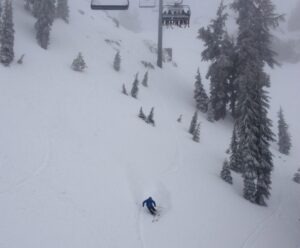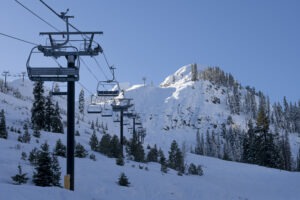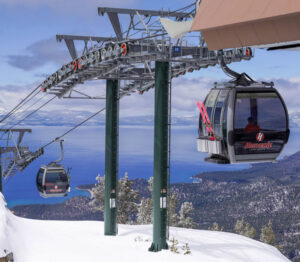A second avalanche this week occurred Thursday at Palisades Tahoe. Fortunately, this time there were no skiers or snowboarders engulfed by the collapsing, fast-moving snow.

The second avalanche came one day after a major avalanche roared down the KT-22 area of the Tahoe ski resort, trapping several people and killing a 66-year-old Kenneth Kidd, a resident of Truckee and Point Reyes.
According to the Placer County Sheriff’s Office, the first avalanche also caused one person to suffer a lower leg injury and two others had unspecified injuries and were later released after a short stay at a local treatment center.
The second avalanche occurred around 12:30 p.m. Thursday (Jan. 11) near the Wolverine Bowl section on the Alpine side of the mountain. No employees or guests were injured, though ski patrol searched the area with probes, beacons and a dog team.
Wednesday’s death at Palisades Tahoe was the first U.S. avalanche fatality of the season, according to the Colorado Avalanche Information Center. Such deaths are far more likely to occur on unmaintained, back-country slopes rather than resort trails.
An average of about 24 people have died annually in avalanches in the U.S. over the past decade, according to the Colorado Avalanche Information Center.
A 2020 avalanche at Alpine Meadows killed one skier and seriously injured another one day after a major storm. Another avalanche at the resort in March 1982 killed seven people, including several employees.
Ethan Greene, the Colorado Avalanche Information Center’s executive director, said ski resorts have become very good at mitigation work and triggering small snowslides intentionally when the slopes are closed to prevent avalanche accidents. Just 3 percent of the 244 avalanche deaths in the U.S. in the past 10 years have been in open, operating areas of ski resorts.
The circumstances that lead to avalanches are multifaceted. A weak layer in the snowpack, a steep slope and a trigger – usually skiers or riders on the slopes. The frequency of human-triggered avalanches in the future will continue to depend in large part on how many skiers and snowboarders recreate in risky backcountry areas.
Mike Reitzell, president of Ski California, a trade association of 36 ski areas in California and Nevada, said ski resorts in avalanche-prone terrain already have programs to reduce the dangers, regardless of the impacts of climate change.

“The slope angles aren’t going to change with climate change,” Reitzell said. “The type of snowpack that there is, whether it’s a wet snow versus a drier snow, those are things they would already be analyzing anyway.”
The KT-22 lift opened for the first time this season just 30 minutes before the Wednesday avalanche. It had been a slow start to the region’s snow season. However, Palisades Tahoe received 25 inches in a five-day period, then got 14 inches during Wednesday’s storm.
Michael Gross, vice president of mountain operations, said before deeming an area safe to open, the team evaluates the conditions relying on their expertise and historical data.
“You know, we’ve got decades worth of weather data that we’re always resourcing or referencing, so looking at current forecasts, looking at all different models, looking at wind speed, snow density, wind direction,” Gross told reporters Wednesday. “There’s a variety of things that go into play and the people that are doing the work are truly experts in their field.”
Placer County sheriff’s officials said Wednesday that the debris field left in the wake of the deadly avalanche was “approximately 150 feet wide, 450 feet long and 10 feet deep.”

The avalanche occurred on steep slopes in the GS Gully area. Gross said ski patrols had been on the slopes checking the avalanche conditions since Sunday.
“They’ve been up there doing control work, evaluating weather conditions, setting up all safety markings, hazard markings, et cetera, to get them prepared for (Wednesday’s) opening,” Gross said at a news conference.
HEAVENLY GONDOLA REOPENS: To the relief of skiers and riders, the popular Gondola at the Heavenly Village reopened Friday morning (Jan. 12), just in time for the always busy Martin Luther King Jr. holiday weekend.
The gondola has been shut down indefinitely due to a mechanical issue that was discovered Thursday morning (Jan. 4).
The gondola transports skiers, snowboarders and sightseers on a scenic 2.4-mile ride up the slopes overlooking the famed waters of Lake Tahoe. It serves as a convenient point of access to the slopes during peak winter days and allows guests to access the famed ski resort without having to get in their car. The gondola drops off skiers and riders on the Nevada side of the ski resort.
“Thanks to our incredible lift maintenance team, the new bearings were installed, the machine has been reassembled, and the Gondola is ready for testing! It will need to operate for testing before we are able to load guests, so you’ll see it spinning throughout the day today,” Heavenly posted on social media.
SIERRA-AT-TAHOE OPENS WEST BOWL: The recent storms over the past week brought enough new snow for Sierra-at-Tahoe open its West Bowl, arguably the best place to ski or ride on the South Lake Tahoe ski resort.
Sierra has received 23 inches of snow in the past week, helping the resort off Highway 50 open additional terrain.
“While we are deeply excited about opening more terrain and a fresh new layer of snow, please keep in mind that early season obstacles do still exist,” a Sierra-at-Tahoe email stated.